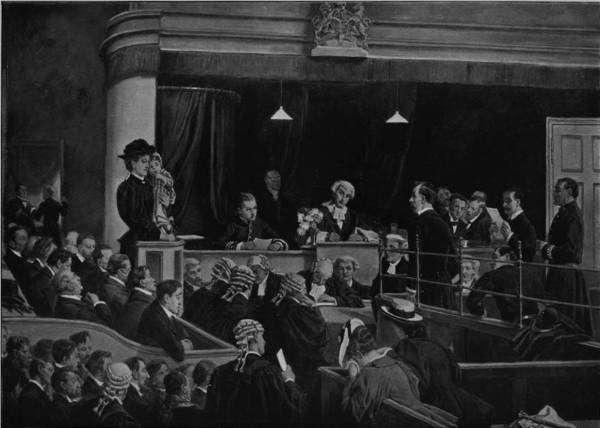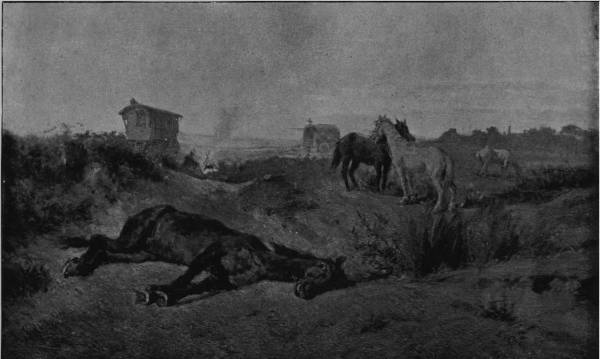

The quotations at the head of each section are taken from Graves' list of Royal Academy exhibitors, and represent the inspiration for the painting, as submitted to the Academy's catalogue by Eyre Crowe.

Title: Drawing Lots for the Guelph Succession at Celle, A.D. 1592 (1896)
Medium: oil
Exhibited: Royal Academy, 1896; Liverpool, 1896
It is stated in the conclusion of Duke Christian's speech to his brother, 'To preserve the splendour of our house only one of us should marry, so that one will be the head of the new line ... ' They drew lots: seven balls, one of which was gilt, the others silvered, were thrown into the helmet ... Fate decided in favour of George the youngest but one, etc.

Reproduced in Royal Academy Pictures, 1896, p. 67
Athenaeum, 2 May 1875:
Drawing lots for a wife and a crown is the occupation of the gentlemen gathered in Mr. Crowe's leading picture about a table in the hall of the palace of Celle or Zell. This is an historic scene, and the decorations, furniture, and lighting are faithfully copied from nature. As was the custom in Germany during the sixteenth century, and even at a much earlier date, a curious and elaborate candelabrum of gilt brass - such as is to be seen depicted in the pictures of Memlinc and Van Eyck - hangs from the roof, immediately over a long table, at which the seven sons of Duke William of Hanover, ob. 1592, have assembled (the ducal races of Germany, being prolific, often had recourse to an expedient of the kind) to draw lots as to which of them shall marry and carry on the succession, the others being content with morganatic alliances. The princes are, on account of their father's death, clad in black: the senior, at the head of the table, is already middle-aged, while the youthful Duke George is sixteen, and another is still younger. The lots being placed in their father's helmet, the fortunate one has fallen to the sixth son George, who is here in the act of receiving the rather boisterous congratulations of more than one of his brothers. The skill and care of the painter in dealing with the various attitudes and expressions are much to be admired. In fact, the incident - a difficult one for a designer - is extremely well expressed and made easy to understand. On our right is an elaborate monument of the deceased duke, comprising the statue of a knight in armour kneeling before the Virgin and Child, which has been brought to the hall for inspection before it is set up in the great church ... The incident is dealt with in Thackeray's lectures on the four Georges.
Art Journal, June 1896, p. 172:
In the class of historical genre we find one or two canvases that deserve attention. Mr. Eyre Crowe's 'Drawing Lots for the Guelph Succession at Celle, A.D. 1592' has a quietly dramatic manner, which is effective in telling its story, and which makes a subject only moderately paintable sufficiently convincing for pictorial purposes.
---------------
Crowe visited Celle in the late summer of 1895, and undoubtedly sketched some of the details of the room there. The picture was exhibited at the Walker Art Gallery in Liverpool in the autumn of 1896.

Title: Charles IX (1896)
Medium: oil
Crowe mentioned working on this painting in his 1896 diary, and it was listed in an inventory of his possessions taken after his death in 1910. It is not known to have been exhibited, and does not appear under this title in the sale catalogues of his remaining works auctioned in 1911.

Title: Trial for Bigamy (1897)
Medium: oil
Size: 30 x 42 inches
Exhibited: Royal Academy, 1897

Reproduced in Royal Academy Pictures, 1897, p. 117
Athenaeum, 15 May 1897:
The visitor who is enquiring after novel bits of genre in this exhibition will find that Mr. Eyre Crowe has hit upon a new and telling subject for his most important work of the year, a comparatively large representation of a Trial for Bigamy (No. 580) in an English court. The first wife, a comely young woman with a child in her arms, is in the witness-box, and nervously gives evidence against the culprit, who does not seem to like his position. The second wife and a sympathetic friend or sister are seated in the lower part of the court; the former hides her face in her handkerchief and weeps silently. The jurymen differ as much as they ought to differ, and every face in the box is full of character; and so are the queer visages of the 'public', all of them more or less unwashed and vulgar. The tragi-comedy of the subject has been sympathetically studied; there are traces of humour here and there, not a little satire, and plenty of spirit... The rough surfaces and somewhat opaque colour of these pictures are unfortunate, and tell greatly against them.
Manchester Courier, 10 May 1897:
Mr Eyre Crowe's 'Trial for Bigamy' (no. 580) is just the kind of picture which the enemies of the Academy quote and requote in their diatribes about the hanging on the line and the rejection of outsiders' works. The picture is certainly an awful example to the would-be Bigamist.
-------------------
Trial for Bigamy is mentioned in Pamela Gerrish Nunn's Problem Pictures: Women and Men in Victorian Painting (1995, p. 65). Nunn contrasts various paintings of the 1880s and 1890s depicting relationships between men and women, which she describes as 'chocolate-box vignettes, vapid pot-boilers ... escapist ... flip', with Crowe's more serious work. Trial for Bigamy depicts a contemporary rather than historical or fictional event, and uses realistic details and muted colours; by these means, 'the adversaries are brought out of the assembled crowd enough to assist the narrative but not so as to melodramatize their roles'. The picture was based on the Crown Court in the Town Hall at Leeds, which Crowe had undoubtedly visited during one of his trips to the north as an Inspector of government art schools.

Title: The Gipsy's Rest (1897)
Medium: oil
Size: 11 x 18 inches
Exhibited: Royal Academy, 1897; Liverpool, 1897

Reproduced in Royal Academy Pictures, 1897, p. 13
Athenaeum, 15 May 1897:
The Gipsy's Rest (815), a smaller picture by Mr. Crowe, has the advantage of a pitiful subject, a half-starved, worn-out horse, which, released from the shafts of the van in the distance, has lain down upon a common, and seems to be breathing his last alone. A little in the rear two other horses - fellow slaves with their dying companion - stand apart, so close together that they seem to be whispering about his fate. Two vans and a group of gipsies cooking their food and heedless of the horses complete the picture... The rough surfaces and somewhat opaque colour of these pictures are unfortunate, and tell greatly against them.
------------------
Crowe made his first sketch of gypsies at Shenfield Common in Essex in May 1873. He rediscovered the sketch more than 20 years later, and made a new painting of the foreground at the same site on 23 July 1896. The picture was exhibited at the Walker Art Gallery in Liverpool in the autumn of 1897.
The picture, then called The Gipsy Encampment, was one of those remaining in Eyre Crowe's possession at his death, and was sold for £2 12 6 at an auction of his remaining works at Christie's in London on 18 March 1911.
A painted sketch for the painting (presumably either the original from 1873 or one executed in 1896), was given to the Fitzwilliam Museum in Cambridge by Michael C. Jaye in 2004. Details of this sketch and an image are available on the museum's online catalogue.

Title: The Crow-Boy (1897)
Medium: oil
Size: 11 x 14 inches (25 x 36 cm)
Exhibited: Royal Academy, 1897; Liverpool, 1897
Athenaeum, 15 May 1897:
The artist's third contribution is styled The Crow-Boy (883). The look and gestures of the ragged country urchin, calling aloud and using a rattle to frighten crows from a cornfield, are decidedly good. The rough surfaces and somewhat opaque colour of these pictures are unfortunate, and tell greatly against them.
------------------
According to Eyre Crowe's diary, he had first painted this subject at Henley in 1872. He found the picture again when he moved his effects out of storage and into his Chelsea studio in 1894, and took the picture on holiday with him to Great Yarmouth, where he traced the outline and began to repaint the boy on the cornfield stile. The picture was exhibited at the Royal Academy in the summer of 1897, and at the Walker Art Gallery in Liverpool in the autumn of the same year. The picture, called Jungen Bursche am Gatten in German, was sold at the Walldorf Auctionhouse, Germany, in July 2002, fetching 3,750 Euros.

Title: Peter the Great (1897)
Medium: oil
Crowe mentioned
this historical composition in his 1897 diary, but it
was apparently never made into a completed picture.

Copyright (c) 2005 Kathryn J. Summerwill. All rights reserved.







